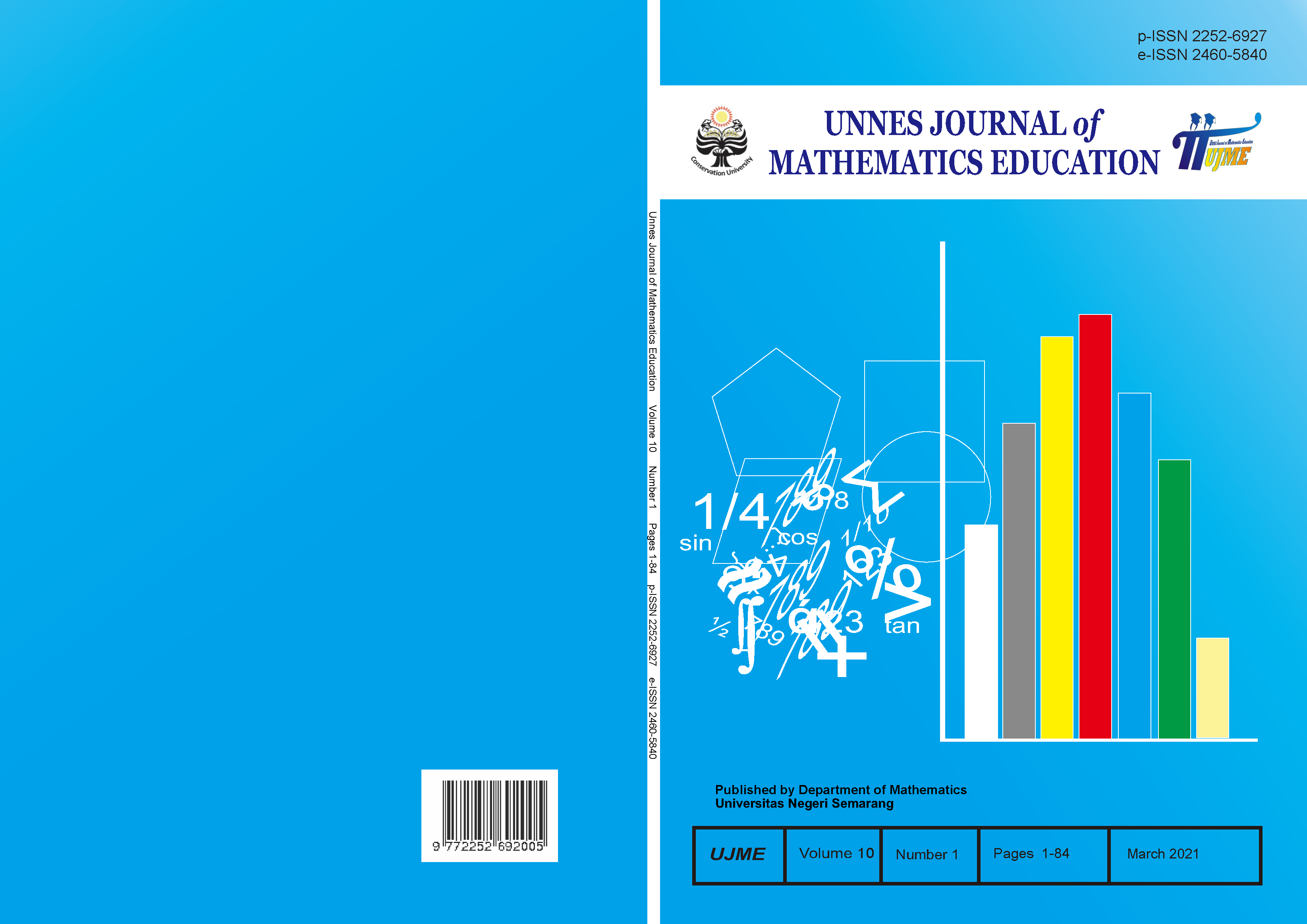Creative thinking mathematical ability of students in Treffinger learning based on cognitive style
##plugins.themes.academic_pro.article.main##
Abstract
This study aimed to test the thoroughness of learning Treffinger for mathematical creative thinking abilities of students, tes the mathematical creative thinking abilities of students in the learning Treffinger compared conventional, and analyze the mathematical creative thinking abilities of students in Treffinger based cognitive style. This study uses a mixed methods design sequential explanatory. The subjects of this study were six students of class VII J SMP Negeri 1 Godong in the even semester of the academic year 2018/2019. Data collection techniques used include: observation, documentation, test, and interviews. The result showed that (1) learning Treffinger due to the ability of creative thinking mathematically, (2) ability to think creatively mathematical students in learning Treffinger higher than the ability to think creatively mathematical students in learning conventional, (3) the ability to think creatively mathematically students on cognitive style is (a) field independent students less able to work on question smoothly and flexibly; can work on new problem correctly ; can write in detail and correctly what is known in the problem, can develop ideas that are owned by being able to draw geometric flat shapes well; (b) intermediet field students less able to work on question smoothly and flexibly; less able to work on new problem correctly; can develop ideas that are owned by being able draw geometry well; (c) field dependent student less able to work on question smoothly and flexibly; less able to work on new problems correctly; less able to develop ideas that have to work on a problem.
##plugins.themes.academic_pro.article.details##
References
Ministry of National Education. (2016). Republic of Indonesia Ministry of Education and Culture No. 21 of 2016 concerning Standard Content of Primary and Secondary Education. Jakarta: Ministry of Natioal Education.
Huda, M. (2013). Teaching and Learning Models. Yogyakarta: Student Library.
Lestari, S., Waluya B., & Suyitno, H. (2015). Analisis Kemampuan Keruangan dan Self Efficacy Peserta Didik dalam Model Pembelajaran Treffinger Berbasis Budaya Demak. Unnes Journal of Mathematics Education Research, 4(2), 108-114.
Munandar, U. (2014). Development of Gifted Children’s Creativity. Jakarta: Rineka Cipta.
Mursidik, E. M., Samsiyah, N., & Rudyanto, H. E. (2015). Kemampuan Berpikir Kreatif Dalam Memecahkan Masalah Matetatika Open-Ended Ditinjau Dari Tingkat Kemampuan Matematika Siswa Sekolah Dasar. PEDAGOGIA: Jurnal Pendidikan, 4(1), 23-33.
Nasution, S. (2010). Various Approaches in the Learning and Teaching Process. Jakarta: Bumi Aksara.
Ningrum, P. (2016). Analisis kemampuan berpikir kreatif matematis berdasarkan gaya kognitif siswa dalam menyelesaikan soal open-ended bertipe problems with multiple solution methods (Doctoral dissertation, Universitas Negeri semarang).
Pomalato, S. W. (2005). The Influence of the Implementation of the Treffinger Model on Mathematics Learning in Developing Creative Capabilities and Solving Mathematical Problem Students. Print_fieldopt_type_phd thesis, Indonesian Education University. http://repository.upi.iedu/1065/ Accessed 18-02-2019.
Pratiwi, L. A., Dwijanto, D., & Wijayanti, K. (2019). Analisis Kemampuan Berpikir Kreatif Matematis pada Pembelajaran Read, Think, Talk, Write Ditinjau dari Kecemasan Matematika. PRISMA, Prosiding Seminar Nasional Matematika, 2, 576-582.
Rahmatina, S., Sumarmo. U., & Johar, R. (2014). Tingkat berpikir kreatif siswa dalam menyelesaikan masalah matematika berdasarkan gaya kognitif reflektif dan impulsif. Jurnal Didaktik Matematika, 1(1), 62-70.
Rohaeti, I. T. (2013). Application of the Treffinger Model on Mathematics Learning to Improve the Middle School Students’ Creative Thinking Ability. S1 thesis, Indonesian Education University. http://repository.upi.edu/2951/ Accessed 19-02-2019.
Siswono, T. Y. E. (2010). Levelling Students’ Creative Thinking in Solving and Possing Mathematical Problem. Journal on Mathematics Education, 1(1), 17-40.
Siswono, T. Y. E., & Novitasari, W. (2007). Meningkatkan Kemampuan Berpikir Kreatif Siswa Melalui Pemecahan Masalah Tipe” What’s Another Way”. Jurnal Trasformasi, 1(1), 1-13.
Solso, R. L., Maclin, O. H., & Maclin, M. K. (2008). Psikologi kognitif. Jakarta: Erlangga..
Sugiyono. (2016). Educational Research Methods. Bandung: Alfabeta.
Susanti, I. T. (2015). Analysis of Student Creativity in Resolving Mathematical Problems Viewed from Reflective and Impulsive Cognitive Style. Thesis. Muhammadiyah University Purwokerto. http://repository.ump.ac.id/14/ Accessed 14-01-2019.
Triwibowo, Z., Dwidayati, N. K.., & Sugiman. (2017). Analysis of Mathematical Creative Thinking Ability Viewed from Students Learning Styles in Seventh Grader Through Treffinger Learning Model with Open-Ended Approach. Unnes Journal of Mathematics Education, 6(3), 391-399.
Ulya, H. (2015). Hubungan gaya kognitif dengan kemampuan pemecahan masalah matematika siswa. Jurnal konseling GUSJIGANG, 1(2).
Witkin, H. A., Moore, C. A., Goodenough, D. R., & Cox, P. W. (1975). Field‐dependent and field‐independent cognitive styles and their educational implications. ETS Research Bulletin Series, 1975(2), 1-64.
